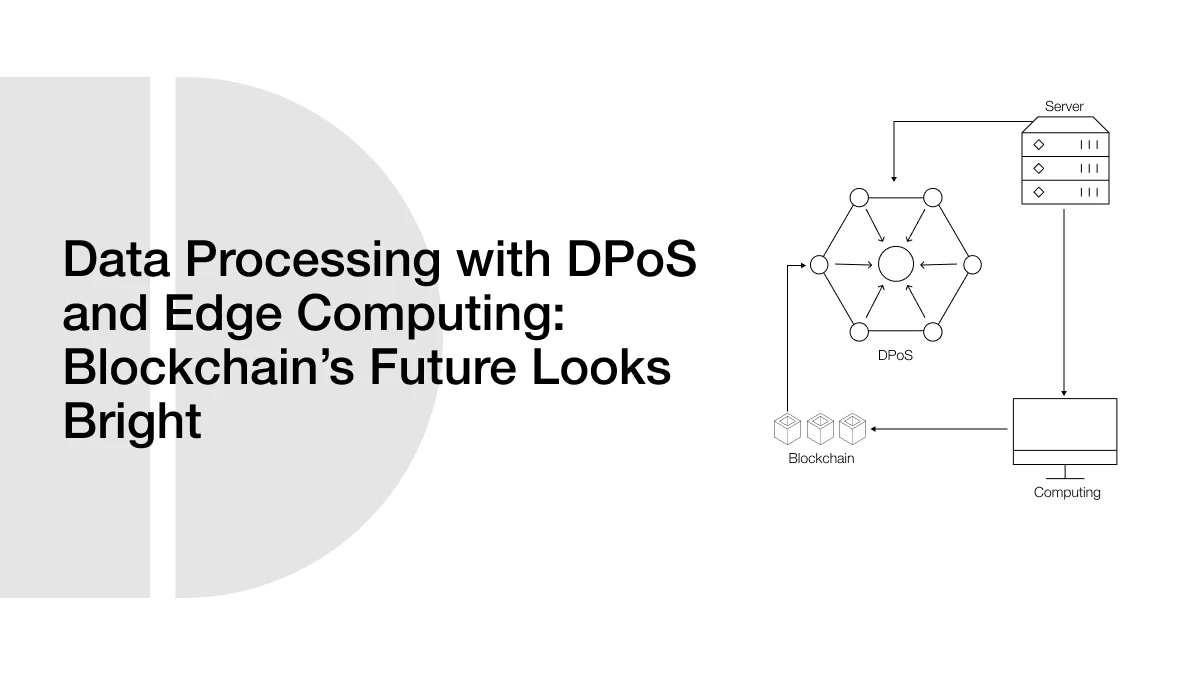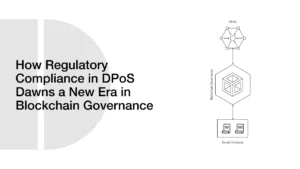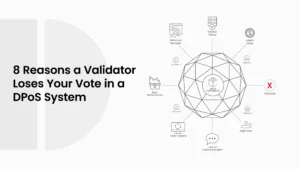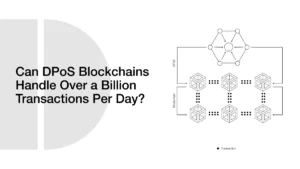Data Processing with DPoS and Edge Computing: Blockchain’s Future Looks Bright

In the digital world today, data is everywhere. From smart traffic lights and factory machines to online shopping and mobile banking, millions of devices are creating information every second. Handling this huge amount of data is not easy. If it’s all sent to a faraway data center, it can cause delays, slow responses, and high costs. This is where edge computing comes in. It processes data close to where it is made, which makes things faster and more efficient.
- What Is Edge Computing?
- How Edge Computing Works
- Edge Computing vs. Cloud Computing vs. Fog Computing
- What Is Delegated Proof of Stake and How Does It Work?
- Key Benefits of DPoS
- PoW vs. PoS vs. DPoS
- Why Combine Edge Computing with DPoS?
- Faster Data Processing for Blockchain
- Reduced Network Congestion
- Better Security and Privacy
- Real-World Use Cases of Edge + DPoS
- Smart Cities
- Supply Chain Management
- Decentralized IoT Networks
- Benefits of Edge Computing in DPoS Networks
- Speed and Latency Improvements
- Lower Costs
- Scalability for the Future
- Challenges of Using Edge and Delegated Proof of Stake Together
- Security Risks
- Complexity in Setup
- Maintenance Needs
- Key Challenges and Solutions
- Future of Edge Computing in Blockchain Governance
- Role in 5G and IoT Expansion
- AI-Powered Delegation
- Global Adoption Trends
- Conclusion
- Frequently Asked Questions (FAQs)
- Glossary of Key Terms
Now, let’s look at Delegated Proof of Stake (DPoS). This is a system used in some blockchains to process transactions quickly and use less energy. Instead of every user doing the work, people vote for a few trusted representatives (delegates) to handle it. This makes the network faster and more organized.
When edge computing and DPoS come together, they can help blockchains handle information in real time. Imagine a smart city where traffic sensors send data instantly to a blockchain system. The edge devices can process the data locally, and the DPoS network can quickly record and verify it. This combination can improve speed, security, and the ability to handle more devices without slowing down.
This blog will explore what edge computing is, how DPoS works, and why combining them could be the future for blockchain systems. It will also look at real-world examples, benefits, challenges, and the future possibilities of using these two technologies together.
What Is Edge Computing?
Edge computing means processing data close to where it is made. Instead of sending all the information to a faraway data center, the system does most of the work near the source. This “source” could be a factory machine, a hospital device, or even a traffic signal. The closer the processing happens to the data, the faster the results.
For example, consider self-driving cars. They have to make decisions within seconds, such as stopping at a pedestrian. If the car had to send the data to a distant server and wait for a response, it might be too late. Edge computing enables the car to process the data on the spot, in real time, thus allowing it to respond in real time as well (Bigelow, 2021).
How Edge Computing Works
In a normal setup, a device collects data and sends it over the internet to a central data center. That center processes the data and sends back the results. This works for many applications, but it can be slow when there’s a lot of data or when quick action is needed.
Edge computing changes that by putting small servers and storage devices closer to where the data is created. This could be in the same premises, on the same road, or even within the machine itself. Such local systems filter, process, and analyze the data and send only the significant parts to the main server.
This is because it minimizes delays (latency), less bandwidth is utilized on the internet, and issues that arise due to slow network are avoided. It is particularly applicable in real-time applications such as video streaming, machine monitoring, and smart city management.
Edge Computing vs. Cloud Computing vs. Fog Computing
| Feature | Edge Computing | Cloud Computing | Fog Computing |
| Location of Processing | Near the data source | Remote data center | Between edge & cloud |
| Latency | Very low | Higher | Medium |
| Best Use Case | Real-time responses | Large-scale storage & analysis | Wide-area IoT systems |
What Is Delegated Proof of Stake and How Does It Work?
Delegated Proof of Stake is one of the techniques that some blockchains follow to validate transactions and append new blocks. Delegates are a small number of people who are trusted to do the work on behalf of token owners, instead of everyone in the network doing the work. These delegates process the transactions and secure the network.
The network can move much quicker and consume less energy than the older systems, such as Proof of Work (PoW), because the work is done by a small group. To illustrate, a Delegated Proof of Stake blockchain can confirm a transaction in only a few seconds, whereas a Bitcoin blockchain can take minutes to do the same.
Key Benefits of DPoS
- Speed is one of the greatest advantages. When fewer individuals are involved in transactions, the system is capable of working faster and undertaking bigger activities simultaneously.
- The other advantage is energy efficiency. It does not consume as much electricity since not all people are contesting to solve puzzles (as in the case of PoW).
- Last but not least, DPoS provides community sovereignty. The holders of the token can delegate or even change them if they are not performing well. This brings about a system in which accountability and trust are important.
PoW vs. PoS vs. DPoS
| Feature | Proof of Work (PoW) | Proof of Stake (PoS) | Delegated Proof of Stake (DPoS) |
| Energy Usage | Very high | Low | Very low |
| Speed | Slow | Medium | Fast |
| Governance | Miners | Token holders | Elected delegates |
Why Combine Edge Computing with DPoS?
Faster Data Processing for Blockchain
When a blockchain uses DPoS, it already processes transactions faster than many other systems. However, with the addition of edge computing, the speed can be even faster. The reason is that edge computing processes information near the place of its creation, and it does not take a long time to reach a central server.
Consider a system of delivery drones, as an example. Both drones make flight data, weather, and location tracking. Should all that data be analyzed at the edge, within the drone, or on a local server, the system will be able to make rapid decisions in real time. Next, only the most significant outcomes can be stored in the DPoS blockchain and verified without wasting time and resources.
Reduced Network Congestion
A big challenge in blockchain is the amount of data that has to travel across the internet. When devices send raw, unfiltered data to a central location, it can slow everything down.
Edge computing fixes this by filtering and processing the data locally. Only the results or significant changes are relayed to the blockchain. This implies that there will be reduced network traffic, fewer delays, and a seamless experience for the users.
Better Security and Privacy
Certain information, such as medical records or financial information, is sensitive and cannot be transmitted freely over the networks. The raw information is secure because edge computing means that the data can be processed locally.
Security is already high in a DPoS blockchain due to encryption and the trust of elected delegates. The inclusion of edge computing implies that sensitive data can be managed and secured even before it is transferred to the blockchain, decreasing the possibility of any leak or cyberattacks.
Real-World Use Cases of Edge + DPoS
Smart Cities
A smart city employs technology to facilitate everyday life and make it easier and more efficient. Traffic signals, public transport, and utilities all measure data each second. This data can be processed in real-time via edge computing and make real-time adjustments, such as shifting the traffic lights or bus routes.
Combined with DPoS blockchain, the noteworthy findings, e.g., traffic reports or energy consumption statistics, could be stored safely and distributed to the corresponding departments. This makes decision-making quick and transparent.
Supply Chain Management
It is a complicated task to monitor goods from the factory to the store. Sensors can monitor temperature, location, and movement in real time. Edge computing processes this data as locally as possible, and it alerts companies the moment something goes wrong, like a shipment being delayed or stored at the incorrect temperature.
ALSO READ: Quantum-Resistant DPoS: How to Future-Proof Blockchain for the Quantum Era
Verified events and updates are then presented in a DPoS blockchain, and it is not possible to alter records in the future. This avoids fraud, enhances trust among partners, and accelerates activities.
Decentralized IoT Networks
In the Internet of Things (IoT), billions of devices, including smart refrigerators and industrial sensors, exchange information. All this data may be sent to a central cloud, which may be delayed and overloaded.
In edge computing, devices or local hubs process data and do not send it anywhere. When used together with a DPoS blockchain, only the most essential actions or alerts are saved, making it cheaper and more reliable.
| Industry | Use Case | Benefit |
| Transportation | Smart traffic signals | Reduced congestion |
| Manufacturing | Machine monitoring | Less downtime |
| Healthcare | Remote patient monitoring | Faster response times |
| Retail | Real-time sales tracking | Better inventory control |
Benefits of Edge Computing in DPoS Networks
Speed and Latency Improvements
Speed is one of the greatest benefits that one can gain by introducing edge computing to a DPoS blockchain. Edge devices analyze data at the point of creation and thus not much delay. This implies that transactions can be posted to the blockchain more quickly and decisions can be made immediately.
As an example, a smart energy grid may have sensors that could monitor changes in power demand and change supply in real time. Processed data is then relayed to the DPoS network, which records the data in a safe manner within a few seconds. Such a speed is difficult to realize with the traditional centralized systems.
Lower Costs
Transfer of bulk data on the Internet may be costly. Edge computing eliminates this issue by computing the majority of the data locally, and only the most significant data is sent to the blockchain. This minimizes the use of the network, decreases the cloud storage expenses, and reduces the total operational costs.
This can translate to considerable savings in the long term without compromising on performance by businesses that operate high-volume blockchain applications.
Scalability for the Future
With the increasing amount of connected devices, blockchain networks will have to process significantly more information. The network without edge computing could become sluggish or demand expensive updates.
Delegated Proof of Stake networks can support more transactions and devices without sacrificing speed using edge computing. This simplifies the expansion of the system as the technology and the demand increase, particularly with the emergence of 5G and IoT devices.
Challenges of Using Edge and Delegated Proof of Stake Together
Security Risks
While both edge computing and DPoS have strong security features, they are not perfect. Edge devices can be targets for hackers because they are often placed in public or remote areas. If a device is not updated or protected well, it can be an easy entry point for attacks.
In a DPoS network, the security of the data depends not only on encryption but also on the trustworthiness of the delegates. If a delegate is compromised, it can affect the whole network.
Complexity in Setup
Combining edge computing and Delegated Proof of Stake is not simple. It requires both strong blockchain knowledge and technical skills for installing and managing hardware. Small companies without dedicated IT teams might find it difficult to launch such a system without outside help.
This complexity means more planning and testing before the system goes live. Without a clear setup process, it’s easy to run into delays or performance issues.
Maintenance Needs
Edge devices are often placed far from central offices, such as in rural areas, factories, or outdoor spaces. This makes regular maintenance a challenge. Devices may need repairs, software updates, or even replacements over time.
Without a maintenance plan, a failed edge device could stop processing data, causing delays or even system downtime.
Key Challenges and Solutions
| Challenge | Solution |
| Device security | Use strong encryption and regular software updates |
| Data management | Filter and process data before sending to blockchain |
| Connectivity issues | Add backup network connections |
| Hardware failures | Create a maintenance schedule and keep spare devices |
Future of Edge Computing in Blockchain Governance
Role in 5G and IoT Expansion
With the advent of 5G, edge computing will be even more potent. 5G is faster, has fewer delays, and is capable of connecting more devices simultaneously. It implies that edge devices can receive and transmit information to a DPoS blockchain almost immediately.
As an example, in a smart transportation system, thousands of traffic sensors, cameras, and self-driving cars may distribute and process information in real-time without saturating the network. These systems will be able to operate happily and securely with the combination of 5G, edge computing, and DPoS.
AI-Powered Delegation
Artificial intelligence (AI) may be used in the future to make DPoS voting smarter. Instead of human votes being the only method of selecting delegates, AI at the edge would have the opportunity to assess network performance and automatically provide the most trustworthy candidates.
This would render the governance process more data-oriented. It would also assist in the detection of a suspicious delegate and alert voters instantly, which would enhance the security of the network and trust.
Global Adoption Trends
Edge computing and high-speed blockchain will be in higher demand as more industries apply IoT devices and real-time data. Delegated Proof of Stake networks are fast, scalable, and energy-efficient; therefore, companies, cities, and even governments may prefer them.
In the coming decade or so, micro data centers, tiny, transportable data centers, may be deployed in urban areas and factories. Such hubs may be linked to Delegated Proof of Stake blockchains directly, and this would form a truly global network where local decisions are made but recorded immutably on a global scale.
ALSO READ: How DPoS and Modular Design Make Faster, Flexible, Secure, and Future-Proof Blockchains
Conclusion
Edge computing and DPoS might be viewed as two separate technologies, but they have one large purpose in common: they make systems faster, more efficient, and reliable. Edge computing makes decisions near the place where the data is generated, and this leads to faster decisions, reduced network traffic, and reduced costs. DPoS enables blockchains to operate at high speed and use less energy, and grants the community power via voting.
Combining these two can create powerful systems for the future. The combination can be seen in action in such real-life situations as smart cities, supply chains, and IoT networks. The advantages are obvious, including easing traffic congestion and tracking the health of the patients in real-time.
The outlook is even more promising as new technologies such as 5G, AI, and micro data centers facilitate the work with data processing and security at the network edge. With more industries and governments using these tools, the future will look like a world where the decisions are made locally and in seconds that are then stored on secure, transparent Delegated Proof of Stake blockchains that everyone can trust.
This is more than just an upgrade to current systems. It’s a shift toward a faster, smarter, and more connected world, and edge computing with Delegated Proof of Stake could be at the heart of it.
Frequently Asked Questions (FAQs)
- What is edge computing in simple terms?
It means processing data close to where it is created instead of sending it to a faraway data center. This makes the process faster and reduces delays. - What does Delegated Proof of Stake stand for in blockchain?
Delegated Proof of Stake is a blockchain method where token holders vote for trusted delegates to confirm transactions and secure the network. - Why combine edge computing with Delegated Proof of Stake?
Combining them allows faster data processing, reduces network congestion, and keeps sensitive information secure before it reaches the blockchain. - What are some examples of edge computing with Delegated Proof of Stake in action?
Examples include smart traffic control in cities, real-time supply chain tracking, and IoT device networks that process data locally before adding key information to the blockchain. - What role will 5G play in edge computing and Delegated Proof of Stake?
5G will make edge computing and Delegated Proof of Stake even faster by reducing delays, supporting more devices, and enabling near-instant data transfer for real-time blockchain applications.
Glossary of Key Terms
- Edge Computing – Processing data near the source instead of a central server to reduce delays and improve speed.
- Delegated Proof of Stake – A blockchain system where token holders vote for a small group of delegates to validate transactions.
- Latency – The delay before data starts moving from one point to another in a network.
- IoT (Internet of Things) – A network of connected devices that collect and share data.
- 5G – The fifth generation of mobile network technology offering faster speeds and lower latency.
- Micro Data Center – A small, portable version of a data center designed for local data processing.




